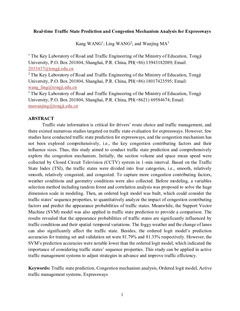报告详情
Real-time Traffic State Prediction and Congestion Mechanism Analysis for Expressways
编号:213
访问权限:公开
更新:2022-07-08 12:10:56
浏览:481次
张贴报告
摘要
Traffic state information is critical for drivers’ route choice and traffic management, and there existed numerous studies targeted on traffic state evaluation for expressways. However, few studies have conducted traffic state prediction for expressways, and the congestion mechanism has not been explored comprehensively, i.e., the key congestion contributing factors and their influence sizes. Thus, this study aimed to conduct traffic state prediction and comprehensively explore the congestion mechanism. Initially, the section volume and space mean speed were collected by Closed Circuit Television (CCTV) system in 1-min interval. Based on the Traffic State Index (TSI), the traffic states were divided into four categories, i.e., smooth, relatively smooth, relatively congested, and congested. To capture more congestion contributing factors, weather conditions and geometry conditions were also collected. Before modeling, a variables selection method including random forest and correlation analysis was proposed to solve the huge dimension scale in modeling. Then, an ordered logit model was built, which could consider the traffic states’ sequence properties, to quantitatively analyze the impact of congestion contributing factors and predict the appearance probabilities of traffic states. Meanwhile, the Support Vector Machine (SVM) model was also applied in traffic state prediction to provide a comparison. The results revealed that the appearance probabilities of traffic states are significantly influenced by traffic conditions and their spatial–temporal variations. The foggy weather and the change of lanes can also significantly affect traffic state. Besides, the ordered logit model’s prediction accuracies for training set and testing set were 81.79% and 81.35% respectively. However, the SVM’s prediction accuracies were notable lower than the ordered logit model, which indicated the importance of considering traffic states’ sequence properties. This study can be applied in active traffic management systems to adjust strategies in advance and improve traffic efficiency.
关键词
暂无
报告人

Wang Kang
Tongji University全部评论
重要日期
-
会议日期
07月08日
2022
至07月11日
2022
-
07月11日 2022
报告提交截止日期
-
07月11日 2022
注册截止日期
主办单位
Chinese Overseas Transportation Association
Central South University (CSU)
Central South University (CSU)
联系方式
- Conference Organizing Committee
- ci******@gmail.com
历届会议
-
2024年07月23日 中国 Shenzhen
第24届海外华人交通协会国际交通科技年会(CICTP 2024) -
2021年12月17日 中国 Xi'an
The 20th and 21st joint COTA International Conference of Transportation Professionals -
2019年07月06日 中国 南京
The 19th COTA International Conference of Transportation Professionals -
2018年07月05日 中国 Haidian District
18th COTA International Conference of Transportation Professionals -
2016年07月06日 中国 Shanghai, China
The 16th COTA conference International Conference of Transportation Professionals -
2013年08月14日 中国 深圳市
International Conference of Transportation Professionals



发表评论